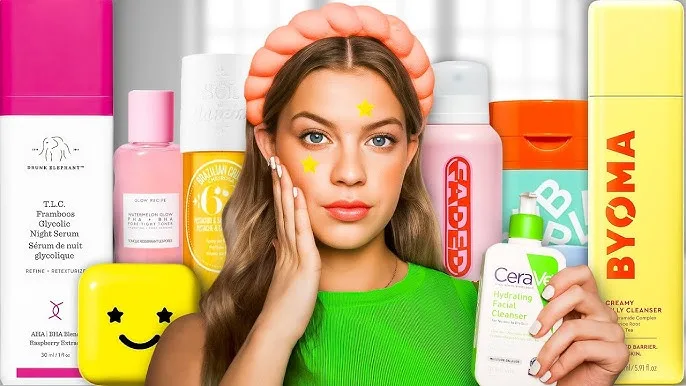News
How to Build a Personalized Skincare Routine: Step-by-Step Guide
Part 1: Understanding Your Skin and Skincare Basics
Building an effective personalized skincare routine starts with understanding your skin, its unique needs, and the fundamental principles of skincare. While beauty trends and marketing claims abound, real results come from knowledge, consistency, and tailoring products to your individual skin type and concerns. In Part 1, we will explore the structure and functions of the skin, the main skin types, common concerns, and the core components of an effective skincare routine.
1. The Anatomy and Function of Skin
The skin is the largest organ in the human body and serves as the first line of defense against environmental stressors. Its structure is layered, each with specific functions:
Epidermis: The outermost layer, responsible for protection, hydration, and barrier function. It contains keratinocytes, which produce keratin for structural support, and melanocytes, which control pigmentation. The epidermis also houses the stratum corneum, the outermost protective layer that prevents water loss.
Dermis: Located beneath the epidermis, the dermis contains collagen and elastin fibers, providing strength, elasticity, and structural integrity. Blood vessels, nerves, and sebaceous glands reside here, delivering nutrients, regulating temperature, and producing natural oils.
Hypodermis (Subcutaneous Layer): The deepest layer, composed mainly of fat and connective tissue, acts as a cushion, insulates the body, and stores energy.
Understanding these layers helps explain why different products target specific depths of the skin and why consistency is key for results.
2. Identifying Your Skin Type
Before creating a personalized routine, it’s essential to determine your skin type. Skin type influences how it responds to products and environmental factors. The main categories are:
Normal Skin: Balanced, not overly oily or dry, with minimal imperfections and a smooth texture. Normal skin benefits from lightweight, hydrating products and a basic protective routine.
Oily Skin: Excess sebum production leads to a shiny complexion, enlarged pores, and potential acne. Products should focus on oil control, non-comedogenic moisturizers, and gentle exfoliation.
Dry Skin: Lacks moisture and natural oils, resulting in flakiness, tightness, or rough texture. Rich creams, nourishing oils, and humectants are ideal for hydration and barrier repair.
Combination Skin: Features both oily and dry areas, often with an oily T-zone (forehead, nose, chin) and drier cheeks. Customized routines balancing lightweight and richer products are necessary.
Sensitive Skin: Easily irritated, prone to redness, burning, or itching. Gentle, fragrance-free, and soothing formulations are recommended, along with patch testing for new products.
Accurately identifying your skin type allows for informed product selection, preventing irritation and maximizing results.
3. Common Skin Concerns
Understanding specific skin concerns helps you tailor your routine to address underlying issues:
Acne and Breakouts: Caused by excess sebum, clogged pores, bacteria, or hormonal fluctuations. Products with salicylic acid, benzoyl peroxide, or natural soothing agents can be effective.
Hyperpigmentation: Dark spots, sun damage, or post-inflammatory marks require ingredients like vitamin C, niacinamide, or licorice root to brighten and even skin tone.
Aging and Fine Lines: Collagen loss, sun exposure, and oxidative stress contribute to wrinkles. Anti-aging products with antioxidants, peptides, and natural oils help maintain elasticity and firmness.
Dehydration: Even oily skin can be dehydrated, appearing dull or tight. Hydrating serums with hyaluronic acid or glycerin restore moisture balance.
Sensitivity and Redness: Often triggered by environmental factors, allergies, or harsh products. Soothing ingredients like aloe vera, chamomile, and oat extract reduce irritation and calm the skin.
Identifying concerns alongside your skin type ensures a targeted approach for the best outcomes.
4. Core Components of a Skincare Routine
An effective skincare routine combines essential steps with products that suit your skin type and concerns:
Cleansing: Removes dirt, oil, and impurities to prepare skin for other products. Gentle cleansers that do not strip natural oils are ideal. Double cleansing may be used for makeup or sunscreen removal.
Toning: Restores pH balance, hydrates, and preps the skin for absorption of subsequent treatments. Toners with soothing and antioxidant properties are preferred.
Serums and Treatments: Concentrated formulations target specific concerns such as acne, pigmentation, or aging. Serums often contain active ingredients like vitamin C, hyaluronic acid, retinol, or plant extracts.
Moisturizing: Hydrates and strengthens the skin barrier. Lightweight lotions suit oily skin, while rich creams and oils benefit dry or mature skin.
Sun Protection: Daily application of sunscreen protects against UVA/UVB rays, preventing premature aging, pigmentation, and skin cancer. Mineral or chemical sunscreens can be chosen based on tolerance and skin type.
Exfoliation (1–3 times per week): Removes dead skin cells, improves texture, and enhances absorption of active ingredients. Chemical exfoliants like AHAs or natural enzymes are gentler alternatives to physical scrubs.
Optional Treatments: Masks, eye creams, or spot treatments can provide targeted benefits when incorporated thoughtfully.
Understanding the purpose of each step allows you to customize your routine effectively.
5. Natural vs. Synthetic Ingredients
Choosing between natural and synthetic ingredients often depends on skin sensitivity, preferences, and desired results:
Natural Ingredients: Plant-based oils, extracts, and butters offer hydration, antioxidants, and soothing properties. They are often gentler, biodegradable, and sustainable. Examples include aloe vera, rosehip oil, green tea extract, and chamomile.
Synthetic Ingredients: Chemically formulated compounds like hyaluronic acid, peptides, or niacinamide provide targeted efficacy and stability. They can complement natural ingredients for enhanced results.
A balanced routine may incorporate both natural and synthetic components, optimizing benefits while minimizing irritation.
6. Importance of Consistency and Patience
Results from skincare are cumulative. Consistent daily care is more impactful than occasional, intensive treatments:
Time for Effects: Most products show noticeable results after 4–12 weeks of consistent use. Anti-aging or pigmentation treatments require patience for visible improvements.
Daily Commitment: Skipping steps or using products inconsistently reduces efficacy and prolongs the time needed to see results.
Monitoring and Adjusting: Track skin response and make gradual changes, introducing one new product at a time to avoid overwhelming your skin.
Consistency, patience, and observation form the backbone of any successful personalized routine.
7. Lifestyle Factors and Skincare
Effective skincare extends beyond products. Lifestyle choices significantly influence skin health:
Nutrition: A balanced diet rich in vitamins, antioxidants, and healthy fats supports skin regeneration and hydration.
Hydration: Drinking adequate water enhances the skin’s natural moisture retention and supports barrier function.
Sleep: Quality sleep allows for cellular repair and regeneration, complementing topical treatments.
Stress Management: Stress can trigger acne, sensitivity, and aging. Practices like mindfulness, yoga, or meditation support healthy skin.
Exercise: Improves blood circulation, enhancing nutrient delivery and promoting a natural glow.
Integrating lifestyle habits ensures that skincare efforts are amplified and sustainable.
8. Tracking Progress and Routine Customization
Personalized skincare requires continual evaluation and adjustment:
Observation: Monitor changes in texture, hydration, clarity, and tone.
Journaling: Document products, routines, and results to identify what works best.
Photography: Monthly photos provide visual tracking of improvements and identify potential issues.
Adjustments: Modify products, concentrations, or frequency based on skin response, season, or lifestyle changes.
Feedback-driven adjustments ensure a routine evolves with your skin, maintaining optimal results.
Summary of Part 1
Understanding your skin and the basics of skincare forms the foundation for a personalized routine. Knowing your skin type, identifying concerns, learning the purpose of each skincare step, and incorporating lifestyle habits are essential. Awareness of natural versus synthetic ingredients, consistency, patience, and regular monitoring ensures that your personalized routine is effective, safe, and adaptable.

Part 2: Step-by-Step Guide to Building Your Personalized Routine
Creating a personalized skincare routine is a process that blends understanding your skin with thoughtful product selection, timing, and technique. While general routines provide guidance, tailoring each step ensures optimal results, long-term skin health, and a routine that suits your lifestyle. In this part, we will explore a practical, step-by-step approach to building a routine, from cleansing to advanced treatments.
1. Step 1: Assessment and Goal Setting
Before purchasing products or starting a new routine, assess your skin and define goals:
Identify Your Skin Type and Concerns: Review whether your skin is normal, oily, dry, combination, or sensitive, and note specific concerns like acne, pigmentation, or aging.
Set Realistic Goals: Decide what you want to achieve—hydration, improved texture, reduced pigmentation, or anti-aging. Realistic, measurable goals help guide product selection.
Consider Lifestyle and Environment: Factors like climate, pollution, daily sun exposure, and work environment influence product choice and frequency.
Assessment ensures that your routine is purposeful and tailored to your unique needs.
2. Step 2: Building a Foundation – Cleansing
Cleansing is the cornerstone of any skincare routine:
Select the Right Cleanser: Choose a formula appropriate for your skin type. For dry skin, gentle creamy cleansers or oil-based options work best. For oily or acne-prone skin, foaming or gel cleansers with mild exfoliants are ideal. Sensitive skin benefits from fragrance-free, soothing cleansers with chamomile or aloe vera.
Technique Matters: Wash your face twice daily, in the morning and evening, using lukewarm water. Avoid hot water, which can strip oils and damage the barrier. Massage in circular motions and rinse thoroughly.
Double Cleansing for Makeup or Sunscreen: Begin with an oil-based cleanser to dissolve makeup or sunscreen, followed by a gentle water-based cleanser to remove residual impurities.
Proper cleansing prepares your skin to absorb the benefits of subsequent products without disrupting its natural balance.
3. Step 3: Toning and Hydration Preparation
Toning restores pH balance, hydrates, and primes skin for treatments:
Choose Your Toner: Hydrating toners with aloe vera, rose water, or glycerin nourish the skin. Exfoliating toners with gentle acids like lactic or glycolic acid promote cell turnover.
Application: Use a cotton pad or fingertips to pat toner evenly across the face. Avoid harsh rubbing, which can irritate sensitive skin.
Purpose: A toner enhances absorption of serums and moisturizers while providing an extra layer of hydration.
Toning bridges cleansing and treatment steps, preparing the skin to receive active ingredients effectively.
4. Step 4: Targeted Treatments and Serums
Serums are concentrated treatments addressing specific concerns:
Select Active Ingredients: Depending on your skin goals:
Hydration: Hyaluronic acid, glycerin, aloe vera
Brightening: Vitamin C, niacinamide, licorice root
Anti-aging: Retinol, peptides, rosehip oil
Acne Control: Salicylic acid, tea tree extract
Application Order: Apply thinner, water-based serums before thicker oils or creams. This allows optimal penetration of active compounds.
Frequency and Gradual Introduction: Introduce one active ingredient at a time, starting with a few nights per week to prevent irritation.
Targeted treatments enhance the routine by addressing individual concerns effectively.
5. Step 5: Moisturizing – Locking in Benefits
Moisturizing maintains hydration and strengthens the skin barrier:
Choose Wisely: Oily skin may prefer lightweight, gel-based moisturizers. Dry or mature skin benefits from richer creams or oils. Combination skin can layer products strategically: lightweight on oily areas, richer on dry zones.
Timing: Apply moisturizer immediately after serums or treatments to seal in hydration.
Ingredients to Look For: Natural oils, shea butter, hyaluronic acid, ceramides, and glycerin support long-lasting moisture and barrier repair.
Moisturizing is essential for healthy, resilient, and plump skin.
6. Step 6: Sun Protection – Non-Negotiable
Sunscreen is the most critical step for preventing premature aging, pigmentation, and skin damage:
Daily Use: Apply broad-spectrum SPF 30 or higher every morning, regardless of weather. UV rays penetrate clouds and windows, causing cumulative damage.
Formulation: Mineral sunscreens with zinc oxide or titanium dioxide are gentle and suitable for sensitive skin. Chemical sunscreens provide lightweight coverage and are ideal for daily wear under makeup.
Reapplication: For prolonged sun exposure, reapply every 2–3 hours.
Sun protection safeguards all previous efforts, maintaining skin health and preventing future damage.
7. Step 7: Exfoliation – Gentle Renewal
Exfoliation promotes cell turnover, smooth texture, and better absorption of treatments:
Frequency: 1–3 times per week depending on skin type and product strength. Over-exfoliation can compromise the skin barrier.
Types:
Chemical Exfoliants: AHAs, BHAs, or fruit enzymes gently dissolve dead skin cells.
Physical Exfoliants: Use sparingly; choose finely milled scrubs to avoid microtears.
Timing: Apply after cleansing and before serums/moisturizers. Follow with hydration to restore moisture.
Proper exfoliation enhances overall skin radiance and smoothness.
8. Step 8: Masks and Occasional Treatments
Masks provide intensive care and address targeted concerns:
Hydrating Masks: Aloe vera, honey, or yogurt masks deliver deep moisture.
Soothing Masks: Calendula, chamomile, or oat masks calm redness or irritation.
Brightening Masks: Licorice root, vitamin C, or fruit enzyme masks help reduce pigmentation.
Frequency: 1–2 times per week based on skin needs and tolerance.
Masks complement daily routines and provide periodic boosts in hydration, nourishment, and repair.
9. Step 9: Tracking Progress and Adjustments
A personalized routine is dynamic and evolves with your skin:
Observation: Monitor changes in texture, hydration, clarity, and tone weekly.
Journaling: Note products, frequency, and results to identify what works.
Seasonal Adjustments: Switch moisturizers, serums, or cleansers based on climate or environmental factors.
Professional Input: Consult dermatologists or skincare experts for persistent concerns or advanced treatments.
Tracking ensures continuous improvement and prevents stagnation or irritation.
10. Step 10: Consistency and Mindful Application
The effectiveness of a routine depends on dedication and intentional use:
Daily Practice: Follow your routine consistently, both morning and evening.
Patience: Results typically appear after 4–12 weeks of regular use.
Mindfulness: Gentle application, avoiding tugging or harsh rubbing, maximizes absorption and prevents damage.
Self-Care Integration: Treat the routine as a ritual for relaxation, confidence, and overall well-being.
Consistency, mindfulness, and patience turn your personalized skincare routine into a sustainable, long-term investment.
Summary of Part 2
Building a personalized skincare routine involves a structured, step-by-step approach: assessing your skin, cleansing properly, toning, applying targeted treatments, moisturizing, protecting from the sun, exfoliating gently, using masks strategically, tracking progress, and maintaining consistency. Tailoring each step to your skin type, concerns, and lifestyle ensures maximum effectiveness, long-term benefits, and healthier, more radiant skin.

Part 3: Advanced Tips, Adjustments, and Long-Term Maintenance for a Personalized Skincare Routine
Once you have established the foundation of your personalized skincare routine, advancing to more sophisticated techniques and maintaining it over the long term ensures sustainable results. Part 3 will explore advanced tips, common mistakes to avoid, seasonal adjustments, integration with lifestyle, and strategies for maintaining healthy, radiant skin over years.
1. Advanced Tips for Optimizing Your Routine
To maximize the benefits of your routine, consider the following:
Layering Strategically: Apply products from thinnest to thickest consistency. Typically, toners → serums → oils → creams → masks. Proper layering ensures optimal absorption and prevents dilution of active ingredients.
Combining Ingredients for Synergy: Certain ingredients enhance each other’s effects. For instance, vitamin C and ferulic acid provide increased antioxidant protection, while hyaluronic acid paired with glycerin boosts hydration.
Time of Application: Some ingredients perform best at specific times. Antioxidants like vitamin C protect during the day, while reparative ingredients like retinol, peptides, and oils are more effective overnight.
Patch Testing and Gradual Introduction: Even natural or gentle products may cause irritation. Introduce one new product at a time, starting with a small amount, and monitor skin reaction over 24–48 hours.
Temperature and Storage: Store products away from heat, sunlight, and moisture to preserve efficacy. Refrigerating certain serums or masks enhances stability and a refreshing sensation during application.
Implementing these advanced techniques ensures that your routine is both effective and safe.
2. Common Mistakes to Avoid
Even well-intentioned skincare routines can encounter pitfalls:
Overloading Products: Using too many products at once can overwhelm the skin barrier, causing irritation, dryness, or breakouts. Focus on quality and essential steps rather than quantity.
Skipping Sun Protection: Sunscreen is non-negotiable. Neglecting SPF reverses all protective and anti-aging benefits of your routine.
Neglecting Seasonal Adjustments: Skin reacts to temperature, humidity, and UV exposure. Failing to adapt your routine can lead to imbalance.
Inconsistent Use: Sporadic application reduces efficacy. Consistency is more important than frequency or intensity.
Ignoring Skin Changes: Hormonal shifts, aging, and lifestyle changes may require adjustments to your routine. Observe your skin regularly and adapt accordingly.
Awareness of these mistakes prevents setbacks and preserves the effectiveness of your personalized routine.
3. Seasonal and Environmental Adjustments
Your skincare routine should evolve with changing seasons and environmental conditions:
Winter: Colder, dry air necessitates richer moisturizers and protective oils to maintain hydration and barrier integrity. Humidifiers can complement topical care.
Summer: Light, gel-based moisturizers and oil-free products reduce heaviness in hot, humid conditions. Sunscreen is even more crucial due to higher UV exposure.
Pollution and Urban Environments: Antioxidant-rich serums, detoxifying masks, and gentle cleansing routines help combat free radical damage from pollutants.
Travel: Changes in climate, water quality, and routine can stress skin. Carry portable hydrating mists, gentle cleansers, and multi-purpose oils to maintain balance.
Adapting your routine ensures continued protection and skin health regardless of external conditions.
4. Integrating Lifestyle Factors
Skincare effectiveness extends beyond topical products. Lifestyle choices amplify results:
Nutrition: Diets rich in fruits, vegetables, antioxidants, and omega-3 fatty acids support cellular repair and barrier function.
Hydration: Adequate water intake enhances skin moisture and aids nutrient transport.
Sleep: Quality sleep promotes cell regeneration and repair.
Stress Management: Chronic stress can exacerbate acne, sensitivity, and premature aging. Mindfulness, yoga, or meditation can improve skin resilience.
Exercise: Boosts circulation, delivering oxygen and nutrients to the skin, enhancing natural glow and absorption of active ingredients.
Skincare and lifestyle synergy ensures long-term skin vitality.
5. Adjusting Products Over Time
Your personalized routine should evolve with your skin:
Age-Related Changes: As skin matures, it may require richer hydration, more potent anti-aging ingredients, or additional barrier support.
Hormonal Fluctuations: Pregnancy, menstrual cycles, or menopause can alter oil production, sensitivity, and hydration, necessitating routine adjustments.
Environmental Shifts: Seasonal changes, travel, and exposure to new climates may require temporary modifications in product types and frequency.
Monitoring Results: Journaling, photography, and skin observation help identify what works and what needs adjustment. Replace or tweak products based on these insights.
Dynamic adaptation ensures your routine remains effective and responsive to your skin’s evolving needs.
6. Long-Term Benefits of a Personalized Routine
Maintaining a consistent, tailored routine over time yields multiple benefits:
Healthy Barrier Function: Moisturization and proper cleansing strengthen the skin barrier, reducing sensitivity and irritation.
Radiant and Hydrated Skin: Regular hydration maintains elasticity, smoothness, and natural glow.
Prevention of Premature Aging: Consistent use of sunscreen, antioxidants, and reparative ingredients reduces fine lines, pigmentation, and loss of elasticity.
Confidence and Empowerment: Knowing your skin’s needs and having a routine that addresses them fosters confidence and a sense of control over your appearance.
Cost-Effectiveness: Personalized routines reduce unnecessary purchases of products that do not work, optimizing both results and spending.
Consistency and personalization lead to cumulative, long-term improvements in skin health and appearance.
7. Combining Natural and Scientific Skincare Approaches
A hybrid approach can enhance results:
Active Ingredients: Retinoids, peptides, and hyaluronic acid can complement natural oils and extracts.
Barrier Support: Natural oils, butters, and plant extracts reduce irritation and enhance skin tolerance to potent actives.
Mindful Integration: Introduce one new active or natural ingredient at a time, monitoring for reactions.
Synergy Benefits: Combining approaches allows targeted solutions while preserving hydration, barrier integrity, and skin resilience.
Blending natural and scientific skincare ensures effectiveness, safety, and holistic care.

8. Psychological and Emotional Benefits
Personalized skincare goes beyond aesthetics:
Mindful Rituals: Applying skincare with intention encourages relaxation and mindfulness.
Stress Reduction: Aromatherapy from essential oils, gentle massages, and self-care routines promote emotional well-being.
Confidence Boost: Healthy skin increases self-esteem and personal satisfaction.
Connection with Nature: Using plant-based or eco-friendly products fosters environmental awareness and holistic wellness.
Skincare becomes a ritual that nurtures both skin and mind.
9. Tracking Progress and Staying Motivated
Regular monitoring sustains motivation and ensures results:
Documentation: Keep notes on products used, frequency, and observed changes.
Photographic Tracking: Consistent monthly photos provide objective progress evaluation.
Adjustment Logs: Record reactions to seasonal changes, new products, or environmental factors.
Celebrate Milestones: Acknowledge improvements, no matter how small, to maintain engagement and motivation.
Tracking builds accountability, encouraging adherence and informed adjustments.
10. Sustainability and Ethical Considerations
Long-term skincare routines benefit from ethical choices:
Eco-Friendly Products: Opt for recyclable packaging, sustainable sourcing, and cruelty-free testing.
Minimal Waste: Avoid over-purchasing, choose multi-purpose products, and practice mindful consumption.
Support Ethical Brands: Favor companies that prioritize transparency, environmental responsibility, and social impact.
DIY Care: When done safely, DIY natural masks or scrubs can reduce chemical exposure and packaging waste.
Ethical and sustainable practices enhance the satisfaction and mindfulness of your routine.
Conclusion of Part 3
A personalized skincare routine is a dynamic, evolving journey that combines foundational care, targeted treatments, and lifestyle integration. Advanced strategies like ingredient synergy, seasonal adjustments, and monitoring progress ensure maximum benefits. Long-term consistency builds radiant, resilient, and healthy skin, while mindful and sustainable practices add emotional and ethical value. By committing to a personalized routine, you invest in lasting skin health, confidence, and holistic well-being.
